+ Open data
Open data
- Basic information
Basic information
| Entry | Database: PDB / ID: 5vlz | |||||||||||||||
|---|---|---|---|---|---|---|---|---|---|---|---|---|---|---|---|---|
| Title | Backbone model for phage Qbeta capsid | |||||||||||||||
 Components Components |
| |||||||||||||||
 Keywords Keywords |  VIRUS / Qbeta / VIRUS / Qbeta /  ssRNA / ssRNA /  phage phage | |||||||||||||||
| Function / homology |  Function and homology information Function and homology informationsuppression by virus of host cell wall biogenesis / suppression by virus of host peptidoglycan biosynthetic process / viral release via suppression of host peptidoglycan biosynthetic process / virion attachment to host cell pilus / T=3 icosahedral viral capsid / adhesion receptor-mediated virion attachment to host cell / translation repressor activity / viral release from host cell by cytolysis /  virion component / symbiont entry into host cell ...suppression by virus of host cell wall biogenesis / suppression by virus of host peptidoglycan biosynthetic process / viral release via suppression of host peptidoglycan biosynthetic process / virion attachment to host cell pilus / T=3 icosahedral viral capsid / adhesion receptor-mediated virion attachment to host cell / translation repressor activity / viral release from host cell by cytolysis / virion component / symbiont entry into host cell ...suppression by virus of host cell wall biogenesis / suppression by virus of host peptidoglycan biosynthetic process / viral release via suppression of host peptidoglycan biosynthetic process / virion attachment to host cell pilus / T=3 icosahedral viral capsid / adhesion receptor-mediated virion attachment to host cell / translation repressor activity / viral release from host cell by cytolysis /  virion component / symbiont entry into host cell / structural molecule activity / virion component / symbiont entry into host cell / structural molecule activity /  RNA binding RNA bindingSimilarity search - Function | |||||||||||||||
| Biological species |   Escherichia phage Qbeta (virus) Escherichia phage Qbeta (virus) | |||||||||||||||
| Method |  ELECTRON MICROSCOPY / ELECTRON MICROSCOPY /  single particle reconstruction / single particle reconstruction /  cryo EM / Resolution: 4.4 Å cryo EM / Resolution: 4.4 Å | |||||||||||||||
 Authors Authors | Cui, Z. / Zhang, J. | |||||||||||||||
| Funding support |  United States, 4items United States, 4items
| |||||||||||||||
 Citation Citation |  Journal: Proc Natl Acad Sci U S A / Year: 2017 Journal: Proc Natl Acad Sci U S A / Year: 2017Title: Structures of Qβ virions, virus-like particles, and the Qβ-MurA complex reveal internal coat proteins and the mechanism of host lysis. Authors: Zhicheng Cui / Karl V Gorzelnik / Jeng-Yih Chang / Carrie Langlais / Joanita Jakana / Ry Young / Junjie Zhang /  Abstract: In single-stranded RNA bacteriophages (ssRNA phages) a single copy of the maturation protein binds the genomic RNA (gRNA) and is required for attachment of the phage to the host pilus. For the ...In single-stranded RNA bacteriophages (ssRNA phages) a single copy of the maturation protein binds the genomic RNA (gRNA) and is required for attachment of the phage to the host pilus. For the canonical Qβ the maturation protein, A, has an additional role as the lysis protein, by its ability to bind and inhibit MurA, which is involved in peptidoglycan biosynthesis. Here, we determined structures of Qβ virions, virus-like particles, and the Qβ-MurA complex using single-particle cryoelectron microscopy, at 4.7-Å, 3.3-Å, and 6.1-Å resolutions, respectively. We identified the outer surface of the β-region in A as the MurA-binding interface. Moreover, the pattern of MurA mutations that block Qβ lysis and the conformational changes of MurA that facilitate A binding were found to be due to the intimate fit between A and the region encompassing the closed catalytic cleft of substrate-liganded MurA. Additionally, by comparing the Qβ virion with Qβ virus-like particles that lack a maturation protein, we observed a structural rearrangement in the capsid coat proteins that is required to package the viral gRNA in its dominant conformation. Unexpectedly, we found a coat protein dimer sequestered in the interior of the virion. This coat protein dimer binds to the gRNA and interacts with the buried α-region of A, suggesting that it is sequestered during the early stage of capsid formation to promote the gRNA condensation required for genome packaging. These internalized coat proteins are the most asymmetrically arranged major capsid proteins yet observed in virus structures. | |||||||||||||||
| History |
|
- Structure visualization
Structure visualization
| Movie |
 Movie viewer Movie viewer |
|---|---|
| Structure viewer | Molecule:  Molmil Molmil Jmol/JSmol Jmol/JSmol |
- Downloads & links
Downloads & links
- Download
Download
| PDBx/mmCIF format |  5vlz.cif.gz 5vlz.cif.gz | 2.7 MB | Display |  PDBx/mmCIF format PDBx/mmCIF format |
|---|---|---|---|---|
| PDB format |  pdb5vlz.ent.gz pdb5vlz.ent.gz | Display |  PDB format PDB format | |
| PDBx/mmJSON format |  5vlz.json.gz 5vlz.json.gz | Tree view |  PDBx/mmJSON format PDBx/mmJSON format | |
| Others |  Other downloads Other downloads |
-Validation report
| Arichive directory |  https://data.pdbj.org/pub/pdb/validation_reports/vl/5vlz https://data.pdbj.org/pub/pdb/validation_reports/vl/5vlz ftp://data.pdbj.org/pub/pdb/validation_reports/vl/5vlz ftp://data.pdbj.org/pub/pdb/validation_reports/vl/5vlz | HTTPS FTP |
|---|
-Related structure data
| Related structure data |  8709MC  8707C  8708C  8710C  8711C  5vlyC  5vm7C C: citing same article ( M: map data used to model this data |
|---|---|
| Similar structure data |
- Links
Links
- Assembly
Assembly
| Deposited unit | 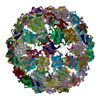
|
|---|---|
| 1 |
|
- Components
Components
| #1: Protein |  Capsid / CP / Coat protein Capsid / CP / Coat proteinMass: 14268.071 Da / Num. of mol.: 180 / Source method: isolated from a natural source / Source: (natural)   Escherichia phage Qbeta (virus) / References: UniProt: P03615 Escherichia phage Qbeta (virus) / References: UniProt: P03615#2: Protein | | Mass: 48613.078 Da / Num. of mol.: 1 / Source method: isolated from a natural source / Source: (natural)   Escherichia phage Qbeta (virus) / References: UniProt: Q8LTE2 Escherichia phage Qbeta (virus) / References: UniProt: Q8LTE2 |
|---|
-Experimental details
-Experiment
| Experiment | Method:  ELECTRON MICROSCOPY ELECTRON MICROSCOPY |
|---|---|
| EM experiment | Aggregation state: PARTICLE / 3D reconstruction method:  single particle reconstruction single particle reconstruction |
- Sample preparation
Sample preparation
| Component | Name: Enterobacteria phage Qbeta Bacteriophage Qbeta / Type: VIRUS / Entity ID: all / Source: NATURAL Bacteriophage Qbeta / Type: VIRUS / Entity ID: all / Source: NATURAL |
|---|---|
| Molecular weight | Experimental value: NO |
| Source (natural) | Organism:   Enterobacteria phage Qbeta (virus) Enterobacteria phage Qbeta (virus) |
| Details of virus | Empty: NO / Enveloped: NO / Isolate: SPECIES / Type: VIRION |
| Buffer solution | pH: 7 |
| Specimen | Embedding applied: NO / Shadowing applied: NO / Staining applied : NO / Vitrification applied : NO / Vitrification applied : YES : YES |
| Specimen support | Grid material: COPPER / Grid mesh size: 400 divisions/in. / Grid type: C-flat-1.2/1.3 |
Vitrification | Instrument: FEI VITROBOT MARK III / Cryogen name: ETHANE / Humidity: 100 % / Chamber temperature: 295 K Details: Blotted for 6s, Plunged into liquid ethane (FEI VITROBOT MARK III) |
- Electron microscopy imaging
Electron microscopy imaging
| Microscopy | Model: JEOL 3200FSC |
|---|---|
| Electron gun | Electron source : :  FIELD EMISSION GUN / Accelerating voltage: 300 kV / Illumination mode: FLOOD BEAM FIELD EMISSION GUN / Accelerating voltage: 300 kV / Illumination mode: FLOOD BEAM |
| Electron lens | Mode: BRIGHT FIELD Bright-field microscopy / Nominal magnification: 30000 X Bright-field microscopy / Nominal magnification: 30000 X |
| Specimen holder | Cryogen: NITROGEN |
| Image recording | Average exposure time: 0.2 sec. / Electron dose: 1 e/Å2 / Detector mode: SUPER-RESOLUTION / Film or detector model: GATAN K2 SUMMIT (4k x 4k) |
- Processing
Processing
| EM software |
| ||||||||||||||||||||||||||||
|---|---|---|---|---|---|---|---|---|---|---|---|---|---|---|---|---|---|---|---|---|---|---|---|---|---|---|---|---|---|
CTF correction | Type: PHASE FLIPPING AND AMPLITUDE CORRECTION | ||||||||||||||||||||||||||||
3D reconstruction | Resolution: 4.4 Å / Resolution method: FSC 0.143 CUT-OFF / Num. of particles: 46471 / Symmetry type: POINT |
 Movie
Movie Controller
Controller




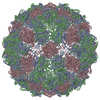
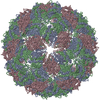
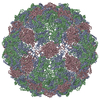
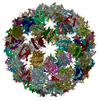
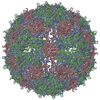
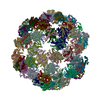
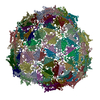
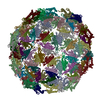
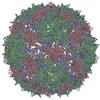
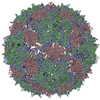
 PDBj
PDBj
